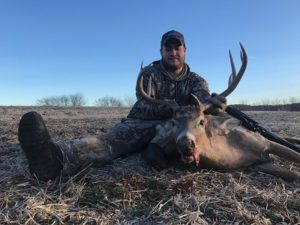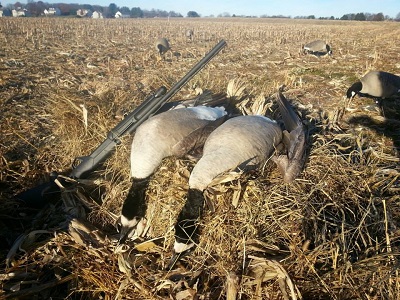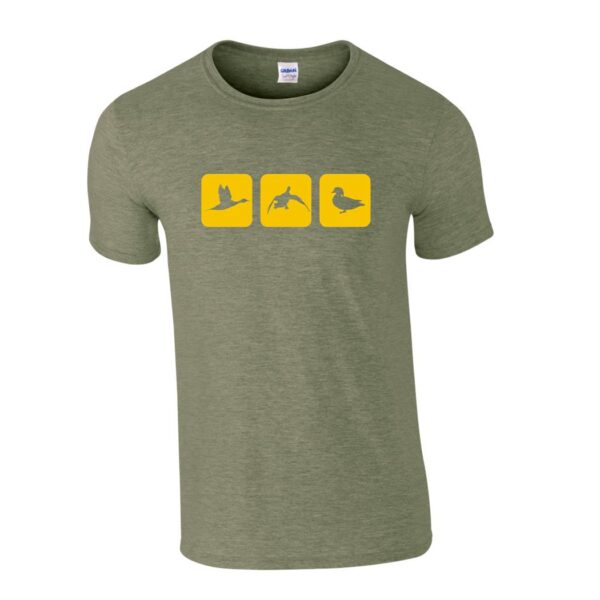Success in the field is a feeling that cannot be explained. Whether it’s harvesting the buck you’ve been after, catching a trophy fish, or retrieving your first goose after working so hard to call it into range, the exhilaration is real.
I started off as a die-hard whitetail deer hunter and still am. However, as the years have passed, I have found myself unexpectedly captivated by another type of hunting… goose hunting.
For The Love Of Geese…
The effort, the precision and the skill that I realized it took to be successful in harvesting geese is what pulled me in. Even though it is not easy to kill a deer, turkey or any other type of animal, goose hunting seemed to require so much more to go right.
That desire for perfection took over. The more I hunted, the more impassioned I became about it. My hunting partners saw how obsessed I was over goose hunting success, that they wanted to try it as well. It was then that I realized how important it was to pass along my newfound knowledge of goose hunting to others.
As outdoor enthusiasts we find ourselves in a very unique industry. Unlike other sports, we do not battle the competition. We instead look to pass along our skill and knowledge to make those who are beside us and those who will come after us better at the sport we’ve grown so passionate over.
Keep reading for some goose hunting tips of the trade!
So, whether it was people I had already hunted with for years, or someone new who expressed the desire to get into the activity, I wanted to help and better them as hunters, as well as continuing to better myself.
Everyone has their own opinions and preferences on how to be successful in goose hunting. And, no one person is more right than the other.
We all have different experiences and techniques that have worked for us. So, here is some of what I have learned during my ongoing journey of being a successful goose hunter.
Goose Hunting Tips And Tricks of the Trade
When it comes to hunting geese, the absolute most important thing I have learned is to pay attention to your surroundings. When putting out decoys, calling geese, and setting up blinds, the best thing you can do is watch what the geese are doing in real life.
Setting Up Goose Decoys
Geese are very wary animals and it doesn’t take much to deter them from coming into your spread. Knowing that, you want your layout to look as natural as possible.
I find myself driving around during the weeks leading up to the season and scouting to see the activities of the birds in the area. Just like you would scout for whitetail deer, find a field or pond full of geese, park your vehicle and just watch how they act.
Know Thy Geese
Pay attention to how they are grouped in the fields, as well as how close or far away they are from one another. Also pay attention to how they are talking and calling when on the ground. You want to mimic the actions of the birds you are hunting to make them as comfortable as possible.
The more comfortable you make the birds, the better the chances are of convincing them to commit to your spread and giving yourself an opportunity at success.
We typically like to set decoys 6 to 8 feet apart from one another. This will give the birds a more relaxed look, as opposed to when they group up when getting nervous and closer to taking off.
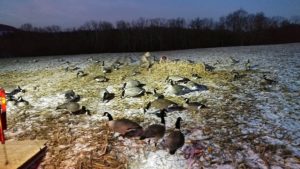
Pay attention to how geese group together so you can mimic that with your decoys.
Decoy Patterns
Multiple styles can be used when setting up decoys around where you yourself will be positioned. Some like laying the decoys out in an “X” pattern. We personally use the “Nike Swoosh” pattern more often. Either will give geese the pocket needed to land in your spread. It often just comes down to personal preference.
Over time, you may learn and try different methods, but these are two commonly used styles that are simple to do. They have proven to work well over the years for the Buck Stoppers crew. Whichever pattern you use, it is important to keep your decoys clean. The birds will often pick up when there is mud or dirt on decoys.
The X Pattern for decoys
For the “X” pattern, you will be setup in the center of the X of decoys and have the wind to your back, as the birds will want to land into the wind to help slow them down.
The Swoosh Pattern for decoys
The swoosh setup has one longer leg of decoys spread out and a shorter run of them to the opposing side, in hopes that the birds land in the pocket created in the center for a desired shot for the hunters.
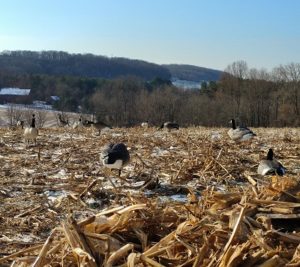
Two popular decoy configurations are the “X Pattern” and the “Nike Swoosh.”
Calling Geese
The part of goose hunting that proves to trouble most people is calling. Mastering a goose call can take quite a bit of time and patience. There are generally two types of calls that are used – a short reed and a flute call. Each person will adapt to calls differently.
Short Reed And Flute Calls
Flute calls prove to me much easier to learn on, as the blowing technique is simpler. Short reed calls allow more advanced calling styles, notes and tones, yet require a much more advanced technique.
For those who have never blown a goose call before, mastering a flute will give you the basics needed, but still provide the sounds you need to talk birds into your spread. Some people love the sounds produced by a flute and never feel the need to move onto a short reed style call.
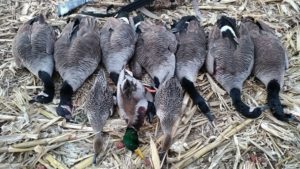
Patience is critical to having a successful goose hunt.
Start by going to an outdoor store or trade show that has a variety of calls and test them out. Each call will be different for every person, so the more you are able to try the better chance you have at finding a call that fits your ability.
Focus on first mastering your honks and clucks. These calls will be the primary ones used in the field. Other sounds produced by geese, such as “come back calls”, moans, and murmurs are ones that you can later pick up as your experience grows and you learn how to control the air and flow techniques.
If you are reading this and find yourself asking, “how do I even begin with mimicking honks and clucks,”rest assured that the internet will prove to be your best friend. YouTube has countless videos on calling basics that will help you begins to produce proper sounds.
-
Sale!

N1 Outdoors® Duck Camo Block Logo Heavyweight Hoodie
$34.00 Select options This product has multiple variants. The options may be chosen on the product page -
Sale!

N1 Outdoors® Est. 2014 Forest Camo Heavyweight Sweatshirt Hoodie
$34.00 Select options This product has multiple variants. The options may be chosen on the product page -
Sale!
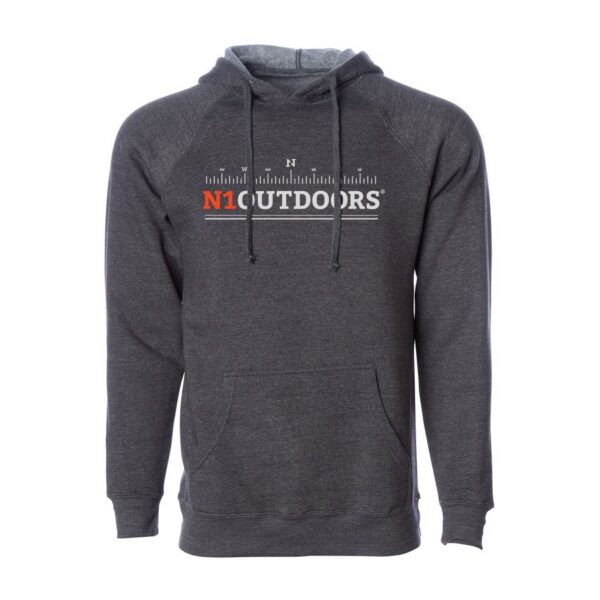
N1 Outdoors® Compass Pullover Hoodie
$34.00 Select options This product has multiple variants. The options may be chosen on the product page
Patience Is Key
Most importantly, be patient when learning to call geese. Everyone is going to learn at a different pace. Too often we see learners get flustered over not being able to produce the sounds they want. If you find yourself unable to produce the noise you’re wanting, find another technique and see if that works for you.
A lot of the calls used in the field can be produced using words and phrases. Saying certain words gives you the similar air flow needed to mimic a goose sound. For example, saying “do-it” into the call is how we always help new comers learn to honk. As you get better and better at calling though, your muscle memory will know the air flow and technique needed and you’ll no longer have to say the words. But trying this method is a great way to start.
Don’t Talk Too Much
When it comes to calling in the field, some people think more is better. This is surely not always the case. Just as I stated earlier, pay attention to your surroundings.
As birds begin to fly within distance of your spread, listen to the sounds they are producing. If the geese are not calling much, we prefer to stay quieter and stick to basic honks and clucks.
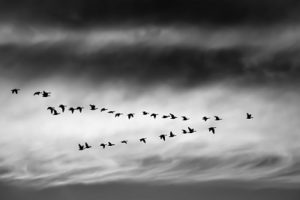
Be careful not to over-call to the geese. Your goal should be to mimic live birds.
Over the years we have seen that if the live birds are not super talkative, over-calling to them provides no benefit to bringing them in. If the geese are more talkative, we call more back to them. Always remember, the goal is to mimic live birds.
The only time we will aggressively call to birds is if they seem to be flying away from our spread. In this instance, we use what is known as “come back calls,” in combination with the honks and clucks we primarily use the rest of the time.
Goose Blinds
The last bit of basic knowledge needed to get into the field and harvest geese is blind types. Every property is going to be different as far as how you are able to hide yourselves when hunting. Most commonly you’ll see pits, layout blinds and above ground blinds.
Pits will be dug into the ground and are the least noticeable by geese. However, not everyone is able to dig up the property where they are goose hunting as needed to build a pit.
Layout blinds are the primary method we use, as they are easily transportable and can be adapted to many different surroundings. They are brushed in and hidden using the foliage or crop in which you are hunting.
Above ground blinds, such as an A-Frame style, are often built with fencing or framed out with camouflage. They can be camouflaged with corn stalks or marsh grasses to help them blend into the surroundings.
Each style will have its benefits, but the most important thing is to spend the time making them blend into their surroundings as naturally as possible.
Conclusion
If you, your family, or friends are on the fence about getting into the sport of goose hunting… don’t look back! Like anything else, the more time and effort you put into mastering this sport, the higher your probability of success.
Hopefully after reading this goose hunting tips article, your basic knowledge of what is needed to get into the field has grown. And, hopefully, you are that much more confident in your ability to learn and adapt to a new style of hunting, of which will surely be rewarding after your first successful harvest.
We wish you the best of luck. And, as always, happy and safe hunting!
